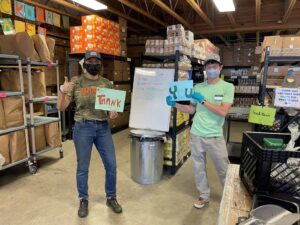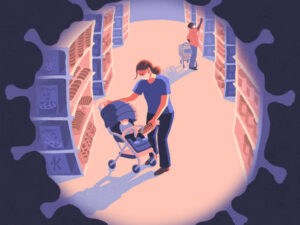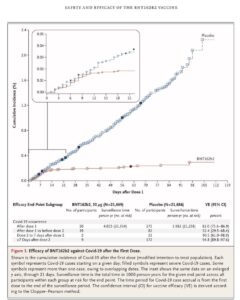Food insecurity
Our Hunger Coalition
November 5, 2021Blaine County, Idaho
While hunger and housing crises have plagued our community for decades, we’ve reached a breaking point. If we don’t make some big decisions in support of working folks, everything we love about our community will be lost.
Recently, we participated in a 50 year vision exercise facilitated by our friend Estefania Mondragon, executive director of PODER of Idaho. Together, our team envisioned what a healthy community will look like decades from now.
Predictably, we envisioned a place with farm-fresh food everywhere. A place where edible gardens and forests grow from every inch of free dirt. We looked to the power of our relationships and dreamed of youth and elders taking care of one another and neighbors sharing meals with abandon. Nice, right?
But there was more to it than that. When we dreamed of the future, working people had somewhere to live, somewhere safe to raise their children; they had medical care, childcare, education, and fair wages. Hunger was something kids learned about in history books.
Then things got harder. Estefania challenged us to name the changes we need to make today to fulfill this vision in fifty years. We are building a plan of action from these very things.
As we draft this plan, there are actions we can all take today to pave the way.
- You can choose leaders who put their energy into our most pressing community needs.
- You could follow the youth activists in our circle and take your message straight to Washington.
- You could join a rally, make a sign, or share an article on social media.
- You can make a donation to The Hunger Coalition so we can not only provide emergency food in times of crisis, but effectively end hunger long-term.
There are a million little things we can each do in the name of progress. Jump over to social media, share your own 50 year vision, and tell all your friends how you are making a difference today. Onward.
In Gratitude,
The Hunger Coalition Team
hunger coalition.org
Heartbreaking.
December 10, 2020Washington Post
(Image: Mikyung Lee for The Post)
Stealing to survive: More Americans are shoplifting food as aid runs out during the pandemic
Retailers, police departments and loss prevention researchers are reporting an uptick in theft of necessities like food and hygiene products.
[Headline only; adverse to paywalls and subscriptions for news and information that should be free for everyone, not only for those who can afford. So I do not subscribe. -dayle]
Instead of two shots, should we be doing one so more are vaccinated, with 65% efficacy instead of 95%?
Vaccines and Decision-Making with Imperfect Data
It’s trade-offs all the way down
|
|
The peer-reviewed paper outlining data from the Pfizer/BioNTech vaccine was just released, as at type, the FDA is holding a meeting which will almost certainly provide emergency authorization for this vaccine. As the editorialaccompanying the paper said, the results are “a triumph.” It’s only December, and we are about to launch mass vaccination with ~95% efficacy in preventing disease—likely even higher for preventing severe disease. Remember that as late as April of this year, experts (including Dr. Fauci) thought 18 months to two years was too optimistic a timeline for a vaccine, and the FDA was ready to approve a vaccine with only 50% efficacy.
Instead, what we have is a vaccine ready at half the time the most optimistic timeline projected, with twice the efficacy hoped for. It’s remarkable.
There’s a lot more to be said, but here’s something that jumped at me while looking at the paper at The New England Journal of Medicine, as well as the files submitted to the FDA. Look at that chart below, comparing detected disease between those in the vaccine and placebo group.
Eyeballing (we don’t have the underlying data), the first shot seems to have 65-80% efficacy in the full group—but we don’t know for how long that lasts. Hence, we have durability of immunity data—for three more months, to day 119—only with the booster shot.
Given the shortages, the potential for single dosing—at least for some populations—or more time between the doses is an important question. It’s possible that a single dose—one that can cover twice the number of people—would provide a significant benefit to the recipients, though we would be unsure about whether the immunity protections last as strongly three months later. This is no minor question. The United States is already planning to withhold vaccination from people unless a second shot has already been secured. If we get fifty million doses now, that’s 25 million people who could be vaccinated now who won’t be even though the doses are sitting in storage.
What should the policymakers do? This seems like a scientific question, but it is not pure science because there are trade-offs on all sides. The question is confronting the dilemmas of not vaccinating millions of people versus vaccinating a smaller group with higher efficacy; and risking a second wave if immunity wears off quickly in an unexpected way. What about trust in vaccines? Can we even do anything that veers, even slightly, from the protocols, let alone something as major as booster timing? Is 60-80% efficacy vaccination for 200 million is better than 95% for 100 million? Given how terrible the next few months look to be, how do we prioritize what we do first? Can we space the booster a bit while we wait for longer-term data? We can model some of what this means depending on who’s vaccinated and whether people adhere to distancing or quarantines after vaccination, but we can’t easily decide which is better without bringing in ethical preferences and thorny questions.
However, at a minimum, we should continue testing as we vaccinate.




